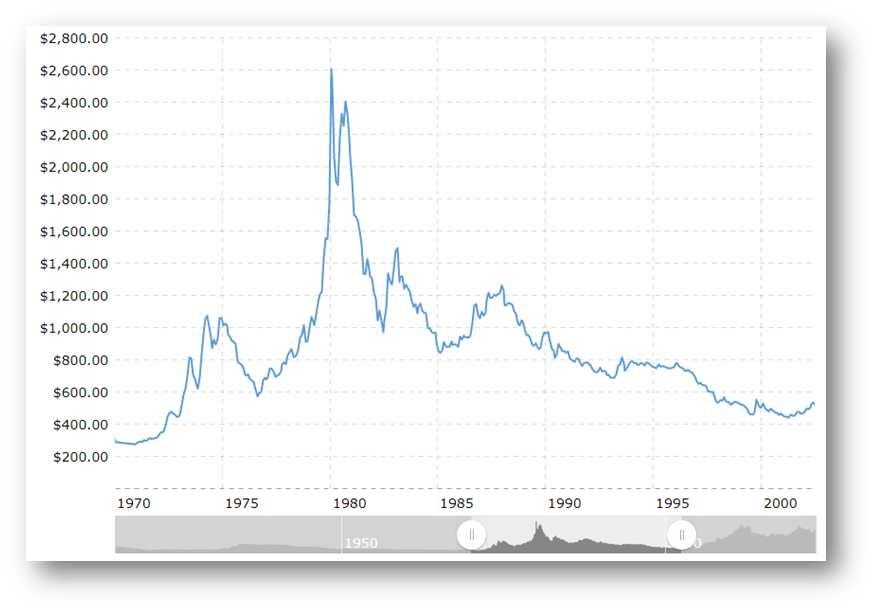Amidst our current environment of higher interest rates, rising prices, a rocky market, and a looming U.S. debt default, some investors who are looking for stability and a way to diversify are turning to gold. But gold is more than just the latest shiny object in investing, it can fit into a long-term investing strategy.
Gold has been an object of interest and desire for humans for thousands of years. In fact, gold is one of the oldest stores of value still being used in our modern financial system. Despite this longevity and widespread use, professional investors and financial advisors hold widely differing opinions when the question of investing in gold arises. Some are proponents of always holding some portion of a diversified investment portfolio in gold. Others say it should be purchased and sold based upon economic conditions or relative valuations to other assets. And yet others are adamant that gold should be avoided altogether.
So why is this long-standing precious metal the source of such differing views when it comes to investing? Professional investors and advisors argue against adding gold to an investment portfolio for several reasons.
The first and most common is that unlike stocks, bonds, and cash, gold does not pay interest or dividends to the owner. Due to this lack of income, it is impossible to calculate a fair value for gold based on expected cash flows. In Warren Buffett’s words, “The problem with commodities is that you are betting on what someone else would pay for them in six months. The commodity itself isn’t going to do anything for you … it is an entirely different game to buy a lump of something and hope that somebody else pays you more for that lump two years from now than it is to buy something that you expect to produce income for you over time.”1
Second, owning physical gold can be expensive. If you own larger amounts of physical gold as an investment, it is wise to securely store and insure your investment. Over time, this can result in a negative yield. Additionally, the cost of buying and selling gold bars, coins, or jewelry typically comes with higher transaction costs than other liquid investments such as Treasury Bills.
Third, some investors choose to hold gold as protection against the demise of the financial system. The bankruptcies of Silicon Valley Bank (SVB), Signature Bank and First Republic Bank this year are reminders that banks can—and do—suddenly fail. Physical gold would most likely be a good financial asset in the very unlikely event our financial system collapses. However, if gold was held in the form of an Exchange Traded Fund (ETF), investors would most likely face the same liquidity concerns SVB and other bank depositors faced this year.
“Diversification is the only free lunch in investing.”
— Harry Markowitz, Nobel Prize winning economist
So, what are the reasons FOR investing in gold? One of the better arguments for including gold as part of an investment portfolio is diversification. The goal of diversification is to maximize investment returns for a given level of risk, otherwise known as “not putting all your eggs in one basket.” A recent white paper published by State Street Bank illustrates that gold can be an effective diversifier. The below chart shows four similar investment portfolios with varying levels of gold (using GLD, an ETF, as the proxy for gold) in each portfolio.2

Each of the portfolios that held some amount of gold outperformed the portfolio absent gold. Additionally, the portfolio that had the greatest drawdown over this period was Portfolio A, which did not own any. This shows that holding gold as part of a diversified portfolio has the potential to reduce volatility and even enhance investment returns. However, it is important to remind investors that this is just one time frame and similar results may not be realized over different holding periods.
Another common reason cited for holding gold is the desire for safety during times of economic stress. A timely example is observing the price of gold since the failure of several regional banks this year. While regional banking stocks, as measured by the S&P Regional Banking ETF (KRE), have lost significant value since early March, GLD has increased by approximately 10% over the same holding period. Additionally, longer term studies have also shown that gold can hold its value or even appreciate during recessions, bear equity markets, or periods of heightened stock market volatility.3
Finally, a third often cited reason to own gold is that it’s an effective hedge against inflation. Gold earned this reputation as an effective protection against high inflation during the 1970s. Annual inflation averaged around 8.8% from 1973-1979, while gold provided a 35% annualized return over this time.4 The inflation adjusted price of gold, illustrated in the chart below, shows this dramatic gain, but also shows much of that appreciation being lost over the following 20 years, when adjusted for inflation:
Gold price per ounce from 1970-2000, price deflated using headline CPI5:

The takeaway from this chart and other longer-term studies is that gold has been effective at protecting against periods of more extreme levels of inflation, but less so during the historically longer periods of lower to moderate inflation.6
Investors have several ways to invest in gold, including buying physical gold such as coins or bullion, investing in gold ETFs or mutual funds, or investing in gold mining stocks. But is it wise to buy gold as a long-term investment? Judging from his 2011 interview with CNBC, Warren Buffett would say no. However, as discussed above, studies have shown that gold can be effective at reducing volatility in diversified portfolios.
As with any investment, it’s important to think through your reasoning for wanting to invest in an alternative asset like gold. And if you’re curious about it, discuss it with your financial planner to see why gold may or may not align with your unique goals and time horizon.
1 CNBC, 2011.
2 State Street Bank White Paper, pp. 16, 2023.
3 State Street Bank White Paper, pp. 6-7, 2023.
4 Forbes.com, March, 10, 2023.
5 Macrotrends.net Gold Prices – 100 Year Historical Chart, 2023.
































0 Comments